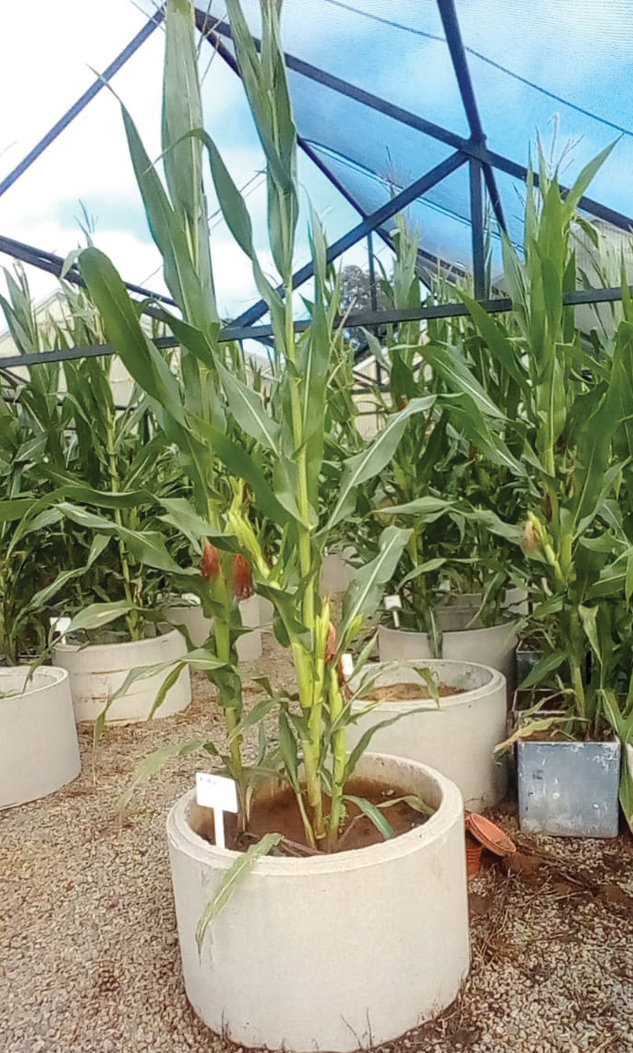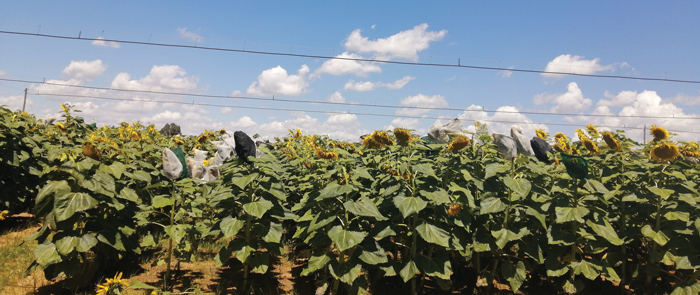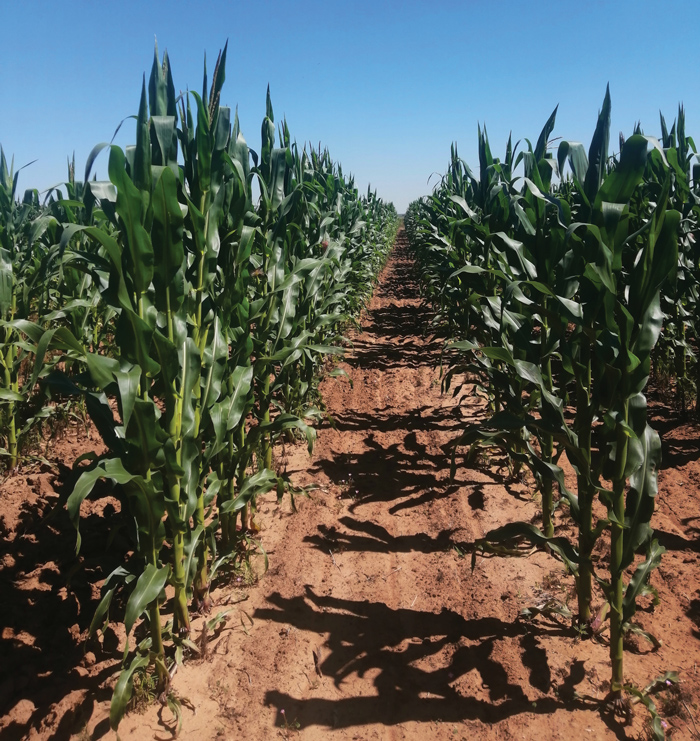
ARC-Grain Crops
 Matome Mochosa,
Matome Mochosa, ARC-Grain Crops
In relation to other sectors, the agricultural sector contributes significantly to the South African economy. Recently, this sector showed a rapid growth despite COVID restrictions and therefore, the importance of the agricultural sector should be acknowledged.
The main industries driving the agricultural sector – and invariably partly driving the South African economy – include the livestock, fruit, horticulture, sugarcane and grain crop industries. Grain crop production contributes to more than 30% of the total gross value of agricultural produce. These crops are South Africa’s most important food crops that occupy more than 60% of hectares that are under cultivation. Apart from human consumption and ensuring food security, grain crops also serve as animal feeds, raw materials for food-processing industries and recently, as a source of biofuel.
Maize, soybean, sunflower, groundnut and sorghum are important summer grain crops in South Africa, while winter grain crops include barley, oats and wheat. The largest area where the highest proportion of grain crops are produced are found in the semi-arid and arid regions of South Africa. For instance, above 60% of the total area grown to maize, sorghum and sunflower is in the semi-arid and arid regions, while 30% of the total area grown with these crops is in the wet regions of the country. Crop production faces many challenges.
Extreme weather conditions due to climate change and climate variability are some of the main challenges in semi-arid regions. Furthermore, the quest to increase the production to meet higher food demands has forced producers to depend heavily on chemically derived fertilisers since a high percentage of these crops are produced on a commercial level. These fertilisers increase input costs and can at the same time be detrimental to both humans and crops.
Continuous use of these inorganic fertilisers can degrade the environment by making the soil more acidic. Nutrient leaching caused by the continuous use of inorganic fertiliser has economic impacts on producers and pollutes ground water if leached below the root zone. The possibility of soil turning saline is also high, which negatively affects a plant’s ability to absorb nutrients and water. Inorganic fertiliser also contributes to greenhouse gas (GHG) emissions because of long-term, unsustainable management practices, especially with grain crop production. There is therefore an urgent need for research on alternative strategies that can reduce the use of inorganic fertilisers.
Biostimulants as an alternative
The increase in demand for better yield and quality of food and crops, has led to the search for eco-friendly and sustainable ways to produce fertilisation reagents of biological origin, which became a major goal in agriculture. Biostimulants are a group of substances from natural origin that contribute to boosting plant yield and nutrient uptake, while reducing the dependency on chemical fertilisers. The application of biostimulants reduces the use of inorganic fertiliser and has become popular nationally and internationally in the production of grain crops.
Not only can biostimulants decrease the need for fertilisers, but it can also cause changes in vital and structural processes, which improve plant tolerance to abiotic stresses and consequently improve and increase seed and/or grain yield and quality. It also enhances nutrient use efficiency in plants through promotion of early root growth and provision of additional beneficial micro-organisms into the soil environment. In addition, the enhanced root growth in plants improves access to water – even in drought conditions. All of these benefits offered by biostimulants enable plants to better cope or adapt to abiotic stresses such as floods, drought, and extreme weather conditions.
On another note, biostimulants are relatively cheap and compacted. The increasing cost of inorganic fertilisers has necessitated the use of efficient biostimulants to retain the agricultural output, without affecting the environment in South Africa.
Types of biostimulants and methods of application
Biostimulants are derived from a wide range of materials, including live microbial cultures, extracts of microbes of animal or plant origin, soil organic compounds (humic acids, fulvic acids), industrial by-products and chemicals, and synthetic molecules. Biostimulants are divided into microbial and non-microbial, based on their attributes and purposes.
Microbial biostimulants mainly address nutrient availability and increase nutrient use efficiency by the plant, while non-microbial biostimulants are extracts that focus on the alleviation of abiotic or biotic stresses in plants. Non-microbial biostimulants can be in the form of pesticides (control of weeds, pests and diseases) to relieve abiotic stress in crops. Biostimulants are, therefore, important in grain crop production, since it can enhance the processes which lead to yield and quality increase.
There are many methods of biostimulant application and these are believed to have a huge effect on the efficacy of the products. The foliar application and sweet spots methods are challenging because of a lack of equipment and technical know-how. Seed dressing with the biostimulant remains the most efficient and has no extra costs during application. These products are available in both liquid and powdered forms.
Use of biostimulants on grain crops
Irrespective of its accessibility, it is mainly commercial producers that use inorganic fertilisers because of production site areas and the ability of inorganic fertiliser to immediately provide nutrients to crops. Grain crops are highly dependent on nitrogen, which makes excessive use of inorganic fertilisers unavoidable. Nitrogen-fixing microbial-based biostimulants are, therefore, often used in the production of these crops to reduce the use of inorganic fertiliser. Some nitrogen-fixing microbial biostimulants are derived from bacteria such as Azotobacter and Azospirillum.
Various biostimulant products from these bacteria have been evaluated on both summer and winter grain crops with favourable outcomes. However, there are still questions to be answered in terms of awareness of biostimulants and adoption of these products among producers. Producers need to understand the different categories of biostimulants, how they affect crops and better ways of application to achieve desired results. All of these summed up into technical know-how, especially crop-specific aspects of the product.
The adequate knowledge of biostimulants will also help producers to manage the handling and storage of the product properly, since these have a huge impact on the efficacy of the products. Biostimulant products are not relatively new in the market, but awareness of it has only been promoted recently, owing to ease of accessibility to information these days. In South Africa there are many prominent biostimulant producers, including fertiliser companies such as Omnia and Kynoch. Despite many companies involved in the production of biostimulants, there are still issues posing challenges to the adoption and realisation of the full benefits of these products. These can be managed through educating extension practitioners and comprehensive involvement of agricultural and research institutes in the country.
ARC working with different stakeholders
In this regard, the mission of the Agricultural Research Council (ARC) is to conduct quality research to ensure a sustainable agriculture sector and to facilitate cooperation between stakeholders such as the Department of Agriculture, Land Reform and Rural Development (DALRRD), producers, extension officers and agrochemical companies. The ARC is actively carrying out research on biostimulants with the relevant biostimulant-producing companies to generate information, which assists the DALRRD to monitor the quality of the products and make informed decisions with regard to product registrations.
The ARC’s Plant Protection Research Institute maintains collections of efficient microbial strains used in biostimulants for research purposes. Currently, ARC-Grain Crops is doing research on various biostimulants regarding their efficacy in different soils, localities and grain crops. These investigations are being carried out in the greenhouse (Photo 1) and under various field conditions (Photo 2) on maize, sunflower and soybean. The aim of ARC-Grain Crops is to continue doing research on these products so that their mechanisms are better understood and to assist producers to obtain higher yields in a sustainable and environmentally friendly manner.



 References
References
Raimi, A, Roopnarain, A & Adeleke, R. 2021. Biofertilizer production in Africa: current status, factors impeding adoption and strategies for success. Scientific African, 11, 1 – 19.



























